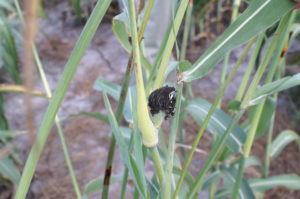
COMMON NAME: Sorghum smut, Covered kernel smut
SCIENTIFIC NAME: Sporisorium sorghi (synonym Sphacelotheca sorghi)
DISEASE DESCRIPTION
Grain sorghum is an important feed grain and silage for livestock in the United States but is consumed by humans in many parts of the world. The fungus that causes sorghum smut grows into the ovaries of the plant and replaces the grain with a fungal structure full of spores, called a sori. For this reason, without controls, smuts can be extremely damaging under the proper conditions to a susceptible sorghum crop.
SYMPTOMS
Individual grains of sorghum are replaced by smut sori, covered by a persistent membrane (peridium). The sori vary in size from those small enough to be covered by the glumes (tiny leaves) to those >1 cm long. Most sori are conical or oval, and resemble an elongated sorghum seed. They are whitish to grey or brown, and may have grey and brown stripes. The sori are 0.4-1.3 cm long and 0.2-0.4 cm wide. Sometimes nearly all of the grains are affected, but frequently heads are only partially smutted. Smut sori may be localized at the top, bottom or side of the infected head.
Unusual symptoms are sometimes observed. Individual spikelets, or inflourescences, may be missing in smutted panicles, the panicle being reduced to a few twisted, distorted branches covered with large, superficial smut sori.
BIOLOGY
Spores of S. sorghi are technically called teliospores. The teliospores are seedborne on a diseased sorghum plant and will germinate within the seed if it is used to plant the following season. Seedling plants become infected, but symptoms generally are not apparent until booting or heading. The pathogen grows within the sorghum as the plant matures into the meristem and thus invades floral tissues. The maturing fungal fruiting structures (sori) rupture and release the teliospores that infect seeds on other plants. Only seedborne spores cause infection. Teliospores adhere to the surface of seeds where they overwinter.
MANAGEMENT METHODS:
- Covered kernel smuts are easily and effectively controlled by treating the seed with a protectant fungicide.
- Where feasible, promptly remove and burn head smut galls before the spores are scattered.
- Since the fungus may live in the soil for several years grow sorghum should be grown in the same field only once in 4 years. Crop rotation could be helpful for the control of the disease. Such a rotation also helps to control other diseases that attack the leaves, heads, stalks, and roots.
RESOURCE LINKS:
https://www.apsnet.org/publications/imageresources/Pages/FI00140.aspx
Covered Kernel Smut – APS Publications
http://ipm.illinois.edu/diseases/series200/rpd208/#top
Sorghum Smuts – Reports on Plant Diseases
https://www.plantwise.org/KnowledgeBank/Datasheet.aspx?dsid=50940
Sorghum smut (Sporisorium sorghi) – Plantwise Knowledge Bank
http://eagri.org/eagri50/PATH272/lecture02/006.html
Diseases of sorghum – Development of a course for B.Sc
This factsheet is authored by Chao Zhang (PhD student)
Factsheet information for the plant health issues represented by the images on the 2019 TPDDL calendar were written by graduate students enrolled in the Department of Plant Pathology & Microbiology PLPA601 Introductory Plant Pathology course in the 2018 Fall semester (course instructor: Dr. David Appel). This exercise provides an opportunity for a high impact learning activity where the students are tasked with producing an informational output directed to the general public and to provide opportunity for the students to write.